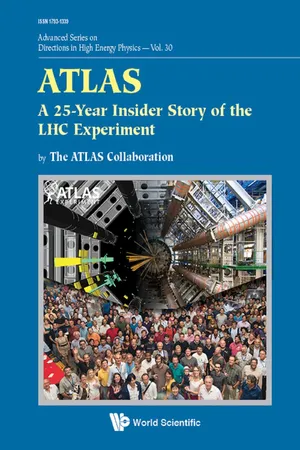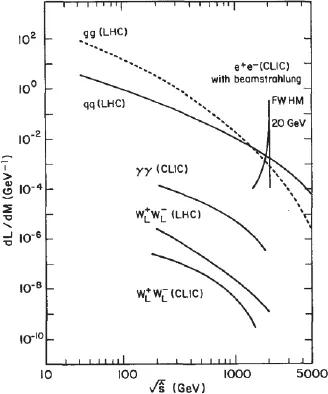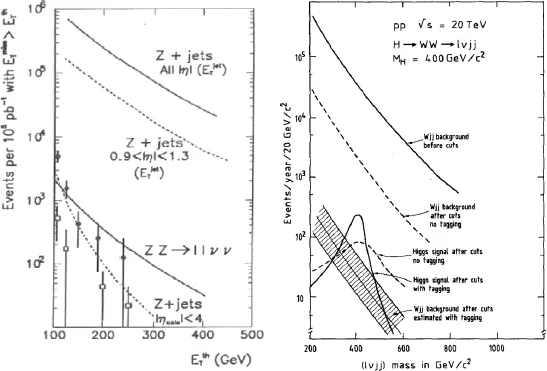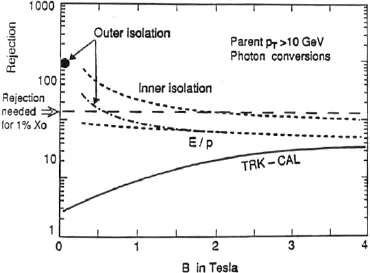![]()
Chapter 1
Towards the ATLAS Letter of Intent
1.1.The early historical context
The confidence in the Standard Model (SM) of particle physics received a giant boost in the early 1980s with the discovery of the W and Z intermediate vector bosons at the CERN proton-antiproton collider by the UA1 and UA2 experiments. Since then, its predictive power has been experimentally demonstrated with great accuracy in many generations of low- and high-energies experiments. And yet, during the 1980s, there were still two elements missing that would had completed the SM and established it fully as the “Standard Theory” of particle physics: the heaviest of the six quarks — the top quark — and a scalar boson of unknown mass, the Higgs boson. The latter would confirm the proposed spontaneous electroweak symmetry breaking mechanism, as a manifestation of the scalar field that permeates the entire universe. This mechanism, introduced by R. Brout, F. Englert and P. Higgs, gives the W and Z bosons their heavy masses and leaves the photon massless. The interactions of quarks and leptons with the scalar field impart masses to them proportionally to the strength of their couplings to the Higgs boson.
The top quark was expected at that time to show up in existing, or soon-to-operate colliders, and its mass became constrained by electron-positron collider (LEP and SLC) measurements and predicted by the electroweak theory to be around its by now well-known value of 172.5 GeV, where it was eventually discovered in 1995 by the CDF and D0 experiments at the Tevatron. In the 1980s, however, the scalar Higgs boson had no significant mass prediction. It could lie in the range from a few GeV up to about one TeV, where it would be so broad that it would experimentally cease to be visible as a signal peak. The mass could therefore be well beyond the reach of any existing experiment at the time. The hunt for the Higgs boson became a central theme in discussing the future of particle physics, and clearly a primary motivation for the Large Hadron Collider (LHC) and its experiments.
In the late 1970s, the idea was already in the air that the tunnel for the future Large Electron-Positron (LEP) collider should be able to house (at some point) a hadron collider, thanks to the foresight of an ECFA-LEP1 Working Group. Thankfully, those leading CERN at the time of the LEP approval in 1981, with H. Schopper as CERN’s Director-General, had the vision to plan for a tunnel with a large enough circumference to reach very high energies, and with a large enough diameter to eventually accommodate the installation of high-field superconducting magnets for such a hadron collider ring.
In the broader community, enthusiasm for a Large Hadron Collider emerged strongly for the first time in 1984, at a workshop in Lausanne on the “Large Hadron Collider in the LEP Tunnel”, which brought together working groups that comprised machine experts, theorists and experimentalists. This workshop is considered in the community, in particular among the experimentalists, as the real starting point for the LHC activities, Quite a number of ATLAS colleagues were already involved at that stage, as individuals concerned about the future of our research. At that time, physics studies and conceptual designs for a very high-energy (40 TeV) proton-proton collider — called the Superconducting Super Collider (SSC) — were already under way in the United States.
With the growing understanding of the great physics potential of a LHC, a series of motivating workshops and conferences followed. They initially included the 1987 workshop in La Thuile organised by the so-called “Rubbia Long-Range Planning Committee”, where the physics potential and the feasibility of a Large Hadron Collider and of a high-energy linear electron-positron collider were debated — this workshop became the basis for the CERN Council’s decision in 1991 that the LHC was the right project for its future after LEP, thanks to the enthusiastic support of C. Rubbia, CERN’s Director-General at that time. The following year, 1988, a dedicated study group about “The feasibility of experiments at high luminosity at the Large Hadron Collider” issued a report to the Long-Range Planning Committee, strengthening the case for the LHC. Detector issues for such a machine were then addressed explicitly during the 1989 study week in Barcelona on the “Instrumentation Technology for High-Luminosity Hadron Colliders”. It was at that meeting where several colleagues, ending up later in ATLAS, decided to start a concerted and coherent effort, in the form of a proto-collaboration, to prepare for a LHC experiment.
CERN management became aware of such emerging groupings and wanted to make sure that its full community had an opportunity to properly discuss the physics and detector issues in a large, open forum. It initiated, together with the ECFA, the 1990 Aachen “LHC Workshop”. This workshop drew a very large attendance, demonstrating the broad support in the community for the LHC. During this time, the design and construction of the 40 TeV SSC was still underway in the United States. The LHC, with its initially planned energy of 16 TeV, could only be competitive when aiming at an order of magnitude higher luminosity, i.e., 1034 cm−2 s−1. However, it was at the Aachen workshop that the formidable experimental challenges for detectors at a high-luminosity hadron collider began to appear solvable, provided enough R&D work on instrumentation was carried out. The SSC was ultimately cancelled in October 1993.
As mentioned, it was during the late 1980s and very early 1990s that the seeds for the future ATLAS and CMS Collaborations were planted. There were initially four proto-collaborations emerging in the early 1990s that aimed at exploratory, general-purpose experiments. They presented detector designs in “Expressions of Interest” at the historically well-known conference “Towards the LHC Experimental Programme” that took place in March 1992 in Evian-les-Bains. It is also during these years that R&D and prototyping work for LHC started. The remainder of this chapter will describe these events in greater detail, which led to the ATLAS Letter of Intent of 1 October 1992. Table 1.1 sketches the timeline of the LHC project.
1.2.The physics case for the LHC: A brief history
As mentioned, the starting point for joint theoretical and experimental activities related to the LHC was the workshop in Lausanne in 1984, during the aftermath of the discovery of the W and Z bosons in UA1 and UA2. At that time, the construction of the Fermilab Tevatron was already in full swing, together with the construction of the CDF detector (joined by the D0 detector soon after), which somewhat mirrored those that had been observed at CERN with UA1 and UA2. At the same time, the LEP machine and its four detectors were also being constructed and the theory community was beginning to deal with increasingly precise and complex predictions for multiple physics processes of interest at high-energy hadron colliders.
Table 1.1. Some key dates of the LHC project.
1984Workshop on a Large Hadron Collider in the LEP tunnel, Lausanne, Switzerland.
1987Workshop on the Physics at Future Accelerators, La Thuile, Italy. The Rubbia “Long-Range Planning Committee” recommends the Large Hadron Collider as the right choice for CERN’s future.
1990LHC Workshop, Aachen, Germany (discussion of physics, technologies and detector design concepts).
1992General Meeting on LHC Physics and Detectors, Evian-les-Bains, France (with four general-purpose experiment Expressions of Interest presented).
1993Three Letters of Intent evaluated by the CERN peer review committee LHCC. ATLAS and CMS selected to proceed to a detailed technical proposal.
1994The LHC accelerator approved for construction, initially in two stages.
1995LHC Conceptual Design Report.
1996ATLAS and CMS Technical Proposals approved.
1996Approval for the construction of the 14 TeV LHC, to be completed in 2005.
1997Formal approval for ATLAS and CMS to move to construction (materials cost ceiling of 475 MCHF).
1997Construction of the experiments commences (after approval of detailed Technical Design Reports of detector subsystems).
2000Assembly of experiments commences at CERN. The LEP accelerator is closed down to make way for the LHC.
2008LHC experiments ready for pp collisions. LHC starts operation. An incident stops the LHC operation.
2009LHC restarts operation, first pp collisions at 900 GeV recorded by the LHC detectors.
2010LHC collides protons at high energy (centre of mass energy of 7 TeV).
2012LHC operates at 8 TeV: announcement of the discovery of a Higgs-like boson.
2015After a shutdown in 2013–2014 the LHC operates at 13 TeV for Run-2.
In this context, it appeared for the first time that it was possible to quantitatively compare the potentials of vastly different accelerators, in terms of answering some of the fundamental questions at the time. These included questions on the existence (or not) of the following: (i) a Higgs boson responsible for the mechanism of the electroweak symmetry breaking, (ii) heavier quarks, including the missing third-generation top quark, and (iii) supersymmetry (see Chap. 9).
So it is not a surprise that the physics potential of ATLAS (and of any LHC experiment) was scrutinised by the community with respect to that of other machines — LEP2 in the short term, Tevatron in the medium term, and SSC and CLIC/NLC (an electron-positron linear collider at 2–3 TeV centre-of-mass energy) in the longer term. The main focus of the comparisons was on the search for the Higgs boson and for supersymmetry. This was the most critical phase for the approval of the LHC project and of its experiments, when the real competition was not between the LHC proto-collaborations but more between soon-to-be-operated and future machines. This is illustrated in the latter case in the historical Figs. 1.1 and 1.2, for comparisons of the basic physics discovery potential of the LHC versus CLIC and SSC, respectively.
The Higgs boson, with its wide variety of possible production mechanisms and decay channels, was an ideal benchmark for physics comparisons, and also for the optimisation of the design of the overall detector in terms of its performance. For the first time in history, theoretical, software and computing tools were available to perform realistic and extensive simulations of the signal and background processes of interest. The development of these tools began in earnest in 1989, and they were all used throughout the various phases of the design, approval and construction of ATLAS.
In the early years of the new century, the painful process of migrating to more modern software tools took place. Today, most of the basic principles of the simulation and many of the algorithms developed then survive in one form or another. This is largely thanks to simulation efforts, which were pursued over a period of twenty years before data taking began, that data and simulation agreed very well in terms of basic detector performance to operate and trigger the experiment with a high efficiency and to publish rapidly important physics results.
Fig. 1.1. Parton luminosities as a function of the centre-of-mass energy Ecm of the constituents (g, q, e, WL) for LHC and CLIC.
Fig. 1.2. Ratios of parton luminosities as a function of the centre-of-mass energy of the constituents (g, q, WL) for LHC and SSC.
In this short survey, only a few examples can be given of the physics and performance simulation work, which led to the ATLAS experiment. Figure 1.3 shows an example of the expected coverage of parameter space in the search for additional Higgs bosons if supersymmetry (MSSM) would be realised in nature. This was shown at the CERN LEP experimental committee in 1996 to compare the LHC potential to that of LEP2, in particular for Higgs boson masses close to that of the Z boson. Figures 1.4 to 1.6 show a few historical examples, without going into detailed explanations, of results from simulations performed during the early design of the experiment in terms of the very critical choices. Figure 1.4 displays the effect of the calorimeter coverage close to the beam (high pseudorapidity η where jets are required to be measured or “tagged” for heavy Higgs boson searches). Figure 1.5 shows one of the impacts of the choice of magnetic field (an option à la UA2/D0 without any magnetic field in the inner detector region was considered initially). Figure 1.6 shows the choice (or not) of a high performance but expensive air-core toroid magnet in the muon spectrometer.
Fig. 1.3. Parameter space for supersymmetric Higgs bosons: mass of the pseudoscalar mA and the ratio of the vacuum expectation values tanβ. Expected discovery contours are shown for various decay modes in the case of ATLAS after ten years of data taking, compared to the expected results from LEP2.
Concluding this short historical overview of how the physics case for ATLAS was developed over the years and how heavily it influenced the detector design, Fig. 1.7 illustrates how the discovery potential for a Standard Model Higgs boson was envisaged more than ten years before data taking began. As will be shown in Chap. 9, the reality is not so different from these early expectations; the main difference arises from the so-called K-factors (higher-order corrections to the dominant Higgs boson production cross section), which were assumed conservatively to be unity during the design phase but turned out later to be much larger. The thrill of a real discovery can only be experienced once in a lifetime, and with real data and the various chapters in this book, is a testimony to that effect.
Fig. 1.4. (Left) Expected rates of events with missing transverse energy ET above a threshold for different calorimeter coverages for the case of events with mismeasured jets in the crack between barrel and endcap cryostats. (Right) Discovery potential for a heavy Higgs boson (400 GeV), expressed as expected rate as a function of the mass of the decay products for the signal and backgrounds with and without jet tagging close to the beam.
Fig. 1.5. Rejection of the electron identification algorithm (isolation, track-calorimeter matching and energy-momentum measurement matching, E/p) against prompt photon conv...





